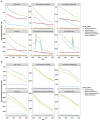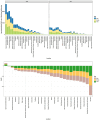Global, regional and national trends in the burden of nutritional deficiencies in children, 1990-2021
- PMID: 40672417
- PMCID: PMC12263351
- DOI: 10.3389/fnut.2025.1565620
Global, regional and national trends in the burden of nutritional deficiencies in children, 1990-2021
Abstract
Background: The objective of this study was to systematically assess global, regional, and national trends in the prevalence and burden of nutritional deficiencies among children aged 0-14 years from 1990 to 2021. Specifically, four major subtypes of malnutrition: protein-energy malnutrition, Vitamin A deficiency, iodine deficiency, and dietary iron deficiency.
Methods: This study utilized data from the 2021 Global Burden of Disease (GBD) database to analyze incidence and disability-adjusted life year (DALY) rates. The estimated annual percentage change (EAPC) was calculated, with the data stratified based on age, gender, region, socio-demographic index (SDI), and country.
Results: Between 1990 and 2021, the global burden of nutritional deficiencies (all ages 0-14 combined) in children declined. The age-standardized DALY rate of dietary iron deficiency had the lowest EAPC (- 0.53; 95% CI: - 0.62, - 0.45). The highest burden of nutritional deficiencies and its subtypes was in Sub-Saharan Africa, but the age-standardized DALY rate of dietary iron deficiency and the age-standardized incidence rate (ASIR) of protein-energy malnutrition were highest in South Asia (1103.19 and 3185.45 respectively). Age-standardized DALYs of protein-energy malnutrition increased substantially in high-income North America (EAPC: 3.30) and Western Europe (EAPC: 2.29). The age group with the greatest burden of nutritional deficiencies and of its subtypes was 0-4 years age group.
Conclusion: From 1990 to 2021, Sub-Saharan Africa has consistently faced the most severe nutritional deficiencies. Meanwhile, South Asia continues to struggle with significant protein-energy and dietary iron nutritional shortfalls. Conversely, high-income North America and Western Europe have experienced a notable rise in protein-energy deficiency.
Keywords: DALY; children; disease burden; incidence; nutritional deficiencies.
Copyright © 2025 Liu, Liu, Yang, Yan, Li and Gao.
Conflict of interest statement
The authors declare that the research was conducted in the absence of any commercial or financial relationships that could be construed as a potential conflict of interest.
Figures




References
-
- World Health Organization . (2020) Factsheets-malnutrition. Available online at: https://www.who.int/news-room/fact-sheets/detail/malnutrition. (Accessed May 31, 2020).
-
- Obasohan PE, Walters SJ, Jacques R, Khatab K. Risk factors associated with malnutrition among children under-five years in sub-Saharan African countries the role of the health care system in the health of children in the United Nations system. A scoping review. Int J Environ Res Public Health. (2020) 17:8782. doi: 10.3390/ijerph17238782 - DOI - PMC - PubMed
-
- Chaudhary AC, Khanapurkar SU, Sirsat GM, Bendale AG, Baviskar SP. Nutritional deficiencies in school-aged children. Int J Pharm Res Technol. (2025) 15:814–9. doi: 10.31838/ijprt/15.01.127 - DOI
LinkOut - more resources
Full Text Sources

